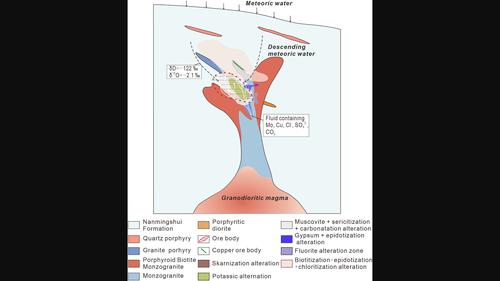The formation mechanism of the Xilekuduke porphyry Mo‐Cu deposit, NW China, revealed by the fluid inclusions and H‐O‐S isotopes
IF 0.8
4区 地球科学
Q3 GEOLOGY
引用次数: 0
Abstract
The Xilekuduke porphyry Mo‐Cu deposit is located in the Altay‐East Junggar region of the Central Asian Orogenic Belt, northwest China. The orebodies occurring as vein type are host within the monzogranite and granite porphyry. Ore minerals include mainly molybdenite, pyrite, and chalcopyrite, whilst the major alteration include potassic, sericite, carbonate, and silicic. Mineralization can be divided into three stages: quartz‐K‐feldspar–polymetallic stage (Stage I), quartz‐polymetallic stage (Stage II), and quartz–calcite–pyrite (minor) stage (Stage III). Three types of fluid inclusion are present in the Mo‐Cu sulfide–calcite–quartz veins: CO

流体包裹体和H-O-S同位素揭示的中国西北部溪勒库都克斑岩型钼铜矿床形成机制
锡勒库都克斑岩型钼铜矿床位于中国西北中亚造山带的阿勒泰-东准噶尔地区。矿体呈脉状赋存于单斜花岗斑岩和花岗斑岩中。矿石矿物主要包括辉钼矿、黄铁矿和黄铜矿,主要蚀变包括钾长石、绢云母、碳酸盐和硅酸盐。矿化可分为三个阶段:石英-长石-多金属阶段(第一阶段)、石英-多金属阶段(第二阶段)和石英-方解石-黄铁矿(次要)阶段(第三阶段)。钼铜硫化物-方解石-石英矿脉中存在三种类型的流体包裹体:含二氧化碳(C 型)、含水(W 型)和含子矿物(S 型)。对流体包裹体的岩相和微测温分析表明,第一、第二和第三阶段的均质化温度分别为 402-499°C、214-391°C 和 136-254°C,相应的盐度分别为 39.2-59.6、3.7-44.9 和 4.1-14.4 wt%氯化钠当量。经测定,石英中流体包裹体的δ18OH₂O 和δD 值分别为 5.3-6.0 ‰ 和 -76 至 -60‰(第一阶段)、1.7-3.2 ‰ 和 -96 至 -90‰(第二阶段)以及 -2.6 至 -2.4 ‰ 和 -106 ‰(第三阶段)。这些结果表明,原生成矿流体(第一和第二阶段)来自花岗岩岩浆,在第三阶段与陨石水混合。硫化物和硫酸盐(无水石膏)的δ34S 值分别为 0.4-5.8‰、13.9-14.4‰,也表明其来源于岩浆。流体的不溶性、陨石水的相互作用以及矿石流体与壁岩的相互作用可能是钼沉淀的关键。
本文章由计算机程序翻译,如有差异,请以英文原文为准。
求助全文
约1分钟内获得全文
求助全文
来源期刊

Resource Geology
地学-地质学
CiteScore
2.30
自引率
14.30%
发文量
18
审稿时长
12 months
期刊介绍:
Resource Geology is an international journal focusing on economic geology, geochemistry and environmental geology. Its purpose is to contribute to the promotion of earth sciences related to metallic and non-metallic mineral deposits mainly in Asia, Oceania and the Circum-Pacific region, although other parts of the world are also considered.
Launched in 1998 by the Society for Resource Geology, the journal is published quarterly in English, making it more accessible to the international geological community. The journal publishes high quality papers of interest to those engaged in research and exploration of mineral deposits.
 求助内容:
求助内容: 应助结果提醒方式:
应助结果提醒方式:


